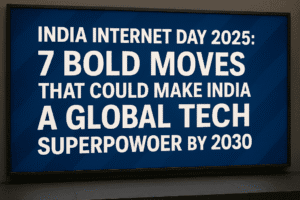India Internet Day 2025: 7 Bold Moves That Could Make India a Global Tech Superpower by 2030
India’s tech ecosystem converged in Gurugram for TiE Delhi-NCR’s India Internet Day 2025, charting a roadmap to transform the nation from a digital economy into a global tech superpower by 2030. With the digital sector growing twice as fast as GDP and projected to contribute 20% of GDP by 2029, the event spotlighted India’s 900 million internet users and rapid adoption of AI, 5G, and groundbreaking public infrastructure like UPI and ONDC. Leaders emphasized AI’s disruptive potential across sectors—from fintech to spacetech—and its role in democratizing access for rural India.
Investors prioritized sustainable scaling in deep-tech and climate solutions, while acknowledging hurdles like regulatory balance and infrastructure gaps. Paytm’s Vijay Shekhar Sharma captured the sentiment: “Building for 1.4 billion people means solutions that work here can go global.” As policymakers and innovators align, India’s blend of grassroots ingenuity and strategic ambition positions it to lead the next decade of tech innovation.

India Internet Day 2025: 7 Bold Moves That Could Make India a Global Tech Superpower by 2030
Gurugram’s Leela Ambience buzzed with anticipation today as TiE Delhi-NCR’s India Internet Day 2025 (iDay) kicked off its 14th edition. The marquee event, convening India’s brightest tech minds—entrepreneurs, investors, and policymakers—has set its sights on an ambitious theme: “India 2030: From Digital Economy to Tech Superpower.”
Why This Matters: India’s Tipping Point
India’s digital economy is sprinting ahead at double the pace of its GDP growth, poised to contribute 20% to the national GDP by 2029. With 900 million internet users and accelerating adoption of AI, 5G, and digital public infrastructure (DPI), the country stands at a transformative crossroads. The question dominating iDay 2025 isn’t if India will emerge as a global tech leader—it’s how.
Key Highlights from the Event
AI’s Cross-Sector Revolution
- Sessions dissected AI’s role in reshaping industries like spacetech, fintech, and public governance. Experts emphasized India’s unique position to leverage AI for scalable solutions, particularly in healthcare, agriculture, and financial inclusion. A recurring theme: AI isn’t just a tool for efficiency—it’s a democratizing force for Bharat (non-urban India).
Digital Public Goods: UPI & ONDC’s Ripple Effect
- India’s homegrown digital infrastructure, like UPI (processing 12 billion monthly transactions) and ONDC (Open Network for Digital Commerce), has unlocked innovation. Startups are now building hyperlocal commerce models and credit solutions for underserved SMEs. The consensus? India’s DPI framework could become a blueprint for emerging economies.
Bharat’s Tech Adoption Leap
- While metros drive innovation, Tier 2/3 cities and rural India are fast becoming adoption hotspots. Panels highlighted how vernacular content, affordable smartphones, and localized AI applications (e.g., Agri-tech chatbots in regional languages) are bridging the digital divide.
Investor Sentiment: Cautious Optimism
- With over 50 VCs and angel investors in attendance, discussions acknowledged a shift from the “growth at all costs” mindset to sustainable scaling. Sectors like deep-tech, climate tech, and SaaS 2.0 (AI-integrated enterprise solutions) emerged as investor favorites.
Voices Shaping the Dialogue
- Sanjeev Bikhchandani (InfoEdge): “India’s talent pipeline—engineers, data scientists, and founders—is our unfair advantage. Global giants will pivot here not just for markets, but for innovation.”
- Upasana Taku (MobiKwik): “Financial inclusion is no longer about bank accounts. It’s about leveraging DPI to create credit ecosystems for 500 million underserved Indians.”
- Akshay Chaturvedi (Leverage Edu): “By 2030, India won’t just export tech services—we’ll export educational frameworks to upskill the world in AI and robotics.”
The Road to 2030: Challenges & Opportunities
While optimism reigns, speakers didn’t shy from hard truths:
- Regulatory Hurdles: Balancing innovation with safeguards in AI ethics and data privacy.
- Infrastructure Gaps: Scaling 5G connectivity and compute power for AI-driven solutions.
- Global Competition: Countering China’s tech dominance and Silicon Valley’s capital muscle.
Yet, India’s grassroots innovation—from DPI to frugal engineering—offers a distinct edge. As Vijay Shekhar Sharma (Paytm) noted: “We build for 1.4 billion people. If it works here, it works *anywhere.*”
The Bottom Line
iDay 2025 isn’t just a conference—it’s a manifesto. India’s tech ecosystem is no longer content with playing catch-up. With collaborative ambition, strategic policy, and a focus on inclusive growth, the goal of becoming a $1 trillion digital economy by 2030 looks within reach. For founders and investors, the message is clear: The next decade belongs to those who build for Bharat and the world.
You must be logged in to post a comment.